March 22, 2017
BURLINGTON, ON
Capturing data that is valid, balanced and detailed enough to tell research analysts what people think and what they would like to see done has been a challenge for the Program Accommodation Review Committee (PAR).
The Halton District School Board hired IPSOS Reid to take on the data gathering and the analysis of the data that was gathered as well as create the questions that would give both the Board, the trustees and the members of the PAR the information thy needed.
If you want to count how many chickens there are in a coop – there have to be some chickens – which is an awkward way of saying that IPSOS Reid was never able to get balanced data.
The first survey they did of parents at a December meeting was so skewered to Central high school parents that it was difficult to project what parents from all seven high schools thought about an issue.
The second survey that ended March 13th does not appear to have been all that much better.
IPSOS Reid presented an Overview of the data gathered on what responders thought of the six options for possible school closing were still on the table. The names given to some of the options were not as clear as they needed to be – for example 7b was to not close any of the high schools and change the Hayden boundaries.
 Most of the options that came forward went through some modifications which added an alpha to the number. Thus 7b had at least two changes made to the original content.
Most of the options that came forward went through some modifications which added an alpha to the number. Thus 7b had at least two changes made to the original content.
The next piece of data explained who was answering the survey – a parent, a student – who?
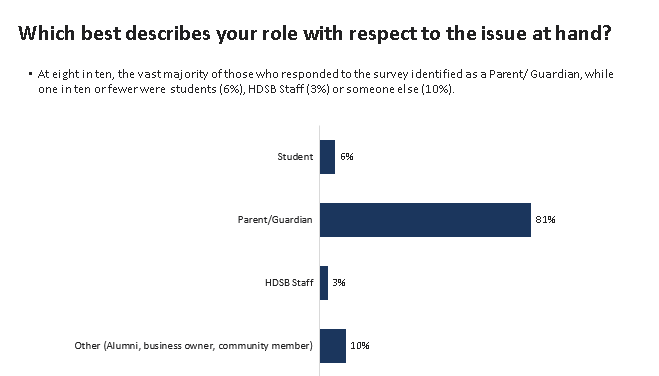 The PARC wanted to know who was responding – – the vast majority were parents.
The PARC wanted to know who was responding – – the vast majority were parents.
Which school did the responder represent as the next concern. What surprised many was that more of the responders came from Nelson high school which while on the list of possible closures was not nearly as at risk as Central, Pearson and Bateman.
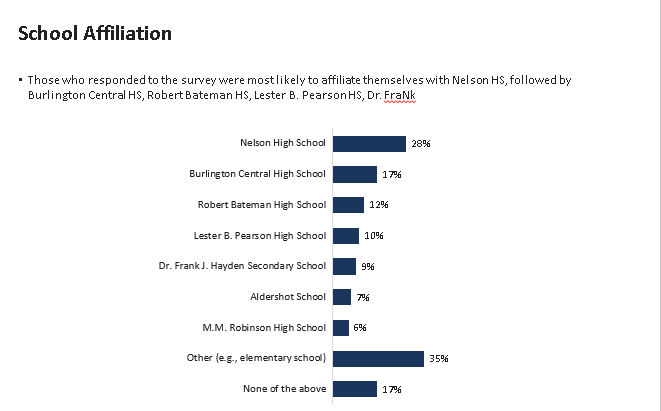 Knowing who was responding to the survey, which schools they represented the researched asked the responder what they thought the impact would be for each option from their perspective.
Knowing who was responding to the survey, which schools they represented the researched asked the responder what they thought the impact would be for each option from their perspective.
The data for all six options was formatted the same way.
We have set these out for each of the six options.
There were 1611 responses to the survey.
People completing the survey had seven choices from most positive to least positive. The blue area indicated people saw this as having a positive impact. grey was neutral, orange indicated a negative impact.
Kirk Perris, the IPSOS Reid researcher did point out that there was no certainty that the responses were all valid by which he meant that he could not say for certain that one person did not complete the survey many times,
He did point out that the average person who did the survey spent 22 minutes doing so which suggested that the bulk of the responses were valid. This wasn’t a survey you could race through.
Perris said the most important part of the survey was the comments people made – that data will be presented to the PARC at their next meeting on Thursday.
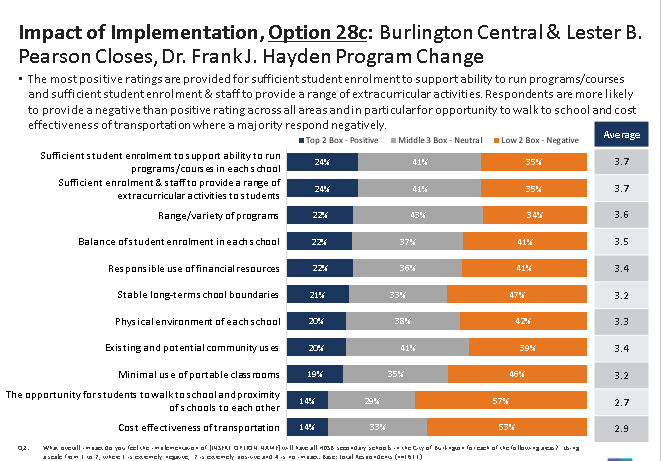
This option is slightly different than the option Board staff originally put forward. It has more to do with boundary changes than the closing of a specific school.
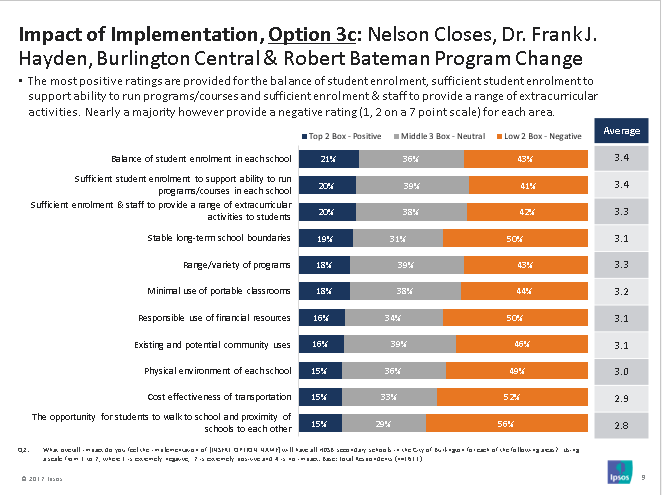
Once this option – closing Nelson was on the table the parents from that high school suddenly got very active. More Nelson parents responded to the survey than any other school – there involvement is reflected in the data.
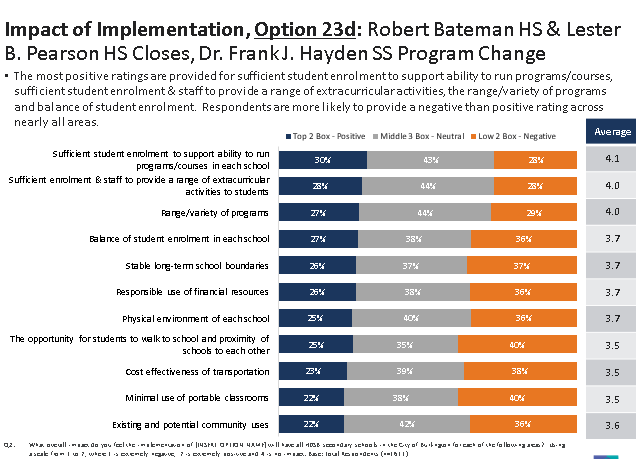
Closing Bateman and Pearson would solve the 1800 empty seats – Parents at Pearson felt that if they were given the students that were taken from them and sent to Hayden they would be viable.
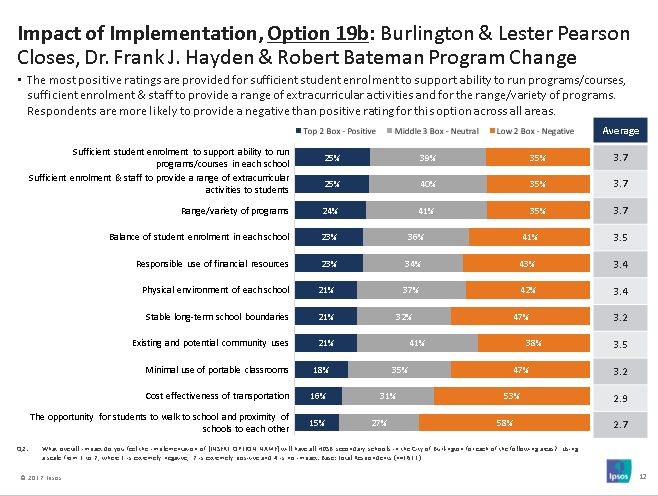
This option was the one the Board staff put forward. It had much higher negative responses than the option that appeared to be the most favoured which was #7 – don’t close any of the schools.
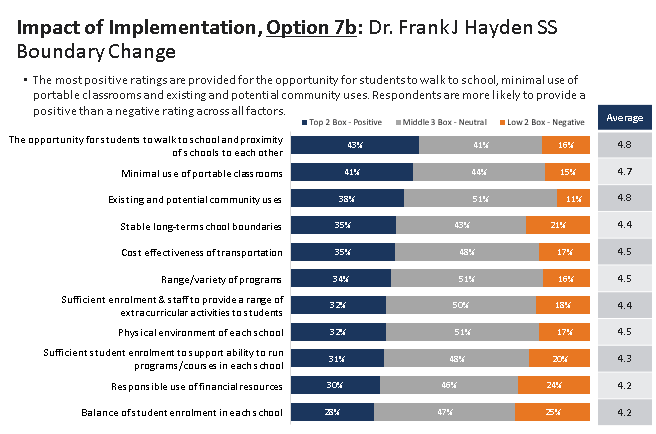
This option to not close any of the schools had the most or highest favourable response – but it doesn’t resolve the problem of those 1800 seats that are empty.
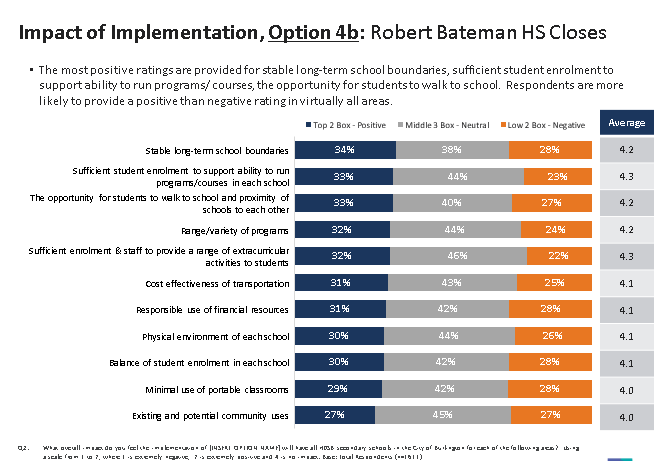
Closing just Bateman was not a clear choice – the positives outweighed the negatives but people felt neutral about many of the questions.














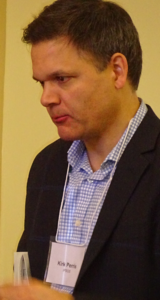







Dear Basic,
You brought up four very important issues.
The most important issue is that the 7 & 8’s at both Aldershot and Central have been excluded from the discussion. This is the biggest foul of the PARC and the public should be up in arms over the exclusion of the 7 & 8’s. If Central closes they will be moved and their parents have been frozen out of the PARC process.
The second issue is AODA, busing and portables at Aldershot. AODA is a mandatory cost and has to be completed by 2026. A seven year program to meet estimated AODA costs at Central, and in my opinion these are inflated costs with to much contingency, is $450,000 per year. Closing Central will result, using Board figures, in increased busing costs of $500,000 per year forever. The rental cost of one portable at Aldershot is estimated to be $60,000. The original plan for Aldershot if Central closes was to have ten portables. That is $600,000 dollars per year. The economics do not make sense. The AODA costs were a smoke screen that was used to distract discussion away from busing issues. Director Miller intervened at a PARC to stop discussion of busing costs.
The third issue is that the Board reports, such as the SIPs and AODA, are complex. They require time to understand, question and discuss. The PARC process was rushed and the time needed to properly conduct the PARC was not there. The Board is now in the position to say the PARC was informed. What the Board cannot say is that the PARC had time to make an informed decision.
The fourth point is not just related to a few machines but is much broader. Let me digress first to those machines. To operate the CNC milling machines require industrial three phase power. That service has to be built into the school at the time of construction or it becomes very expensive to retrofit. The older schools had that service built in to them if they were going to have a technical wing. Of the seven urban high schools in Burlington, only Robinson and Bateman can accommodate this machinery. The broader picture is the other investments that will be lost. One of the best auditoriums in Ontario is at Central. The only floating basketball court in a high school in Halton is at Central. No one builds floating hardwood basketball courts anymore.
Much will be lost if Central closes. Many students will be bused forever. The cost, both to the students, their parents and the public, have not been properly addressed.
Peter Menet
Dear Basic,
Please review the School Information Profiles (SIPs) on the HDSB website before spreading further misinformation
Central was not finished in the 1920’s as you seem to believe. There were three major additions. The largest addition, comprising 40 to 45% of its floorspace, was completed in 1966. This addition, which included classrooms, the auditorium, an additional gym and technical wing, is a fine example of the high school infrastructure that was built during the ’50’s through ’70’s. All classrooms, gyms, laboratories, and technical facilities are fully functional. For example the machine shop has two new programable CNC vertical axis milling machines on which students train.
Another example is that the addition at Central that was completed in 1956 is interchangeable with Nelson’s “new” construction of 1956.
Finally, at the PARC meetings Director Miller has stated on numerous occasions that costs related to AODA are not a deciding factor.
Please refer to section 1. Facility Profile of the SIPs and review the valuable information that is presented there on all the high schools.
Peter Menet
Robotics Mentor
Peter,
Thank you for your reply, and I did take an look at the SIP once I had read your comment. That information is not what I would call easily accessible, hence the reason I did not see it.
I did not say that the school was non-functional, I just said that it was older, like many of the other facilities, and I picked the oldest school as an example.
That is fantastic that they have those CNC machines, however, those are not dependent on that particular facility. Some of the other schools could host those machines, those machines do not have anything to do with the building it self.
I am aware that the AODA costs are not part of the deciding factor, however, that is still information that some people may consider to be important. The same goes with Central Strong’s point about the Elementary schools. As the directory stated, the elementary schools do not hold an weight when it comes to the deciding factors.
This survey is completely useless. None of the data on is accurate, especially since only 6 percent of the respondents are the students. The majority of respondents are affiliated with Nelson, so of course, they will be totally against Nelson closing. 99 percent of the parents who responded, do not know what it is best for them. High school isn’t the same as it was in the 80’s and 90’s. Only the students, and staff members that are directly involved in the boards high schools know “what is best” for the students. This is about the students, and not some alumni that have already graduated. These two groups are the two groups that are most underrepresented in this survey.
A boundary change at this point will not make up for the approximate 1800 unfilled pupil spaces. We basically have one empty White Oaks (north and south campuses) open. These schools are not cheap to run, and our board can not afford to have 1800 empty pupil spaces. Many of Burlington’s facilities (Central in particular, which was finished in the 1920s), are outdated, cost more money to fix up, bring up to AODA compliance, etc. Our board should not have built Hayden, however they did, and now we must deal with the consequences. 7b is not at all feasible, even though this survey says that it is the best option.
Oh, and by the way, kids are not going to walk 3km to school. No ones going to walk for 30-40 min.
Basic,
&b is feasible. Just pay attention to all the ways it can be done.
You apparently are not as you have your mind made up.
The extended PAR process for another month will provide the ways.
Your opinion of the survey is also extreme, like the feasibility of 7b. Once all the comments and patterns become evident, the parents seem to want 7b, which also includes Nelson parents.
There is information in there, but you just dismiss it without showing us why.
Keep posted and open your mind.
Tom,
7b, in its current form is not feasible. Two large schools (MMR and RBHS), still have utilization rates of under 65 percent. 1554 pupil spaces (according to the 7b option document) are still not being utilized. Thats around an 300 pupil space reduction, which is good, but its not good enough for our board. None of the options are perfect, but 48 (option 19b, is my example), comparred to 1554 is an huge difference.
I don’t have my mind made up actually, but, at least in my option, 7b is not feasible as it currently stands. Now that being said, I do not want any schools to close. But unfortunately, I am pretty sure that we are beyond the point were an boundary change can solve the board’s issues.
Basic,
I’m uncertain when you first chimed in on this discussion, as your comment background reasoning is thin compared to what has been written about the subject here.
You seem new here. Can you date your initial place in this discussion?
There are many comments and stories that cover in detail problems with the data and forecast models and assumptions that the Board is using to project enrollment and the long term trends in utilization and empty seats.
These methods and numbers have been roundly criticized and are in the Gazette archive. I have neither the time or patience to go over all this again for you here, as it seems you are relatively uninformed of this body of information. I have written about a number of these things at length.
The average Burlington utilization of 75 to 80% can be achieved at all schools, including those below 65%, with a general reshuffle of all the boundaries and programs. This is feasible.
This can be done to explore what it involves, but it has not been.
The Board overall is nowhere near in dire straits, and empty seats in Burlington are around 4% of the total Board seats.
This squeeze on Burlington’s schools is because Hayden was built, and created basically all of the surplus seats we now have.
This was done under agreement with the Ministry that part of the cost of Hayden would be recovered by the future disposition of surplus assets.
This PAR is what that agreement is all about – that noted future is now. And please don’t just accept this as too bad and we have to deal with all these newly created empty seats by sacrificing the schools that existed before.
In any case, what one thinks as feasible is not totally objective, but contains a large component of subjectivity.
What you think of as feasible or not feasible is not concrete, but is your opinion. Others differ.
There are many things that can be done to enable all schools to stay open.You seem unfamiliar with much that has been written right here in the Gazette, and discussed at PARC meetings.
You would do well to review the Gazette archive, and Councilor Meed Ward’s newsletters and comments on this.
These feasibility factors just have not had time allowed in this PAR to be fully considered.
7b-like options just have not been fully examined.
Overall, if we want all schools to stay open, then we can decide to do just that, and allow time to make that work.
It’s worth noting that a PAR member asked to see all the comments, not just the ones the board is going to select to highlight and was told, once again, that would be too much work because they would need to delete anything that personally identifies the person who did the survey.
1611 responses. I am guessing hardly any had comments where the person identified themselves in any way. Surely a couple of people at Ipsos who the taxpayers are paying (to do what exactly?) could spend a few hours going through and hitting delete on those that do.
These comments contain the unfettered judgements and opinions of the respondents. As you indicate, is this not what we want to know? – a PAR member says yes.
Saying it’s too much work is just another indicator that the Board doesn’t know what it’s doing.
At the least, it makes them look like crooks again.
It lets a contract to IPSOS to do a public survey, but doesn’t include sufficient time or resources to provide all the results.
It’s all taxpayer money, and done to inform the taxpayers, but too much work to get the most important results.
Pay more taxpayer money. Get it done.
The methodology developed for this survey is consistent with the botched management of the entire PAR process . Ipsos presented the survey results with the caveat they were not reliable. This process was arranged for public input and now the public is being told they cannot have access to the analysis of their responses . At an earlier meeting Ipsos stated they had to discount all the previous data because of the weighting of Central data and now they are saying they have to discount this data because of the high percentage of Nelson data. These were not unexpected outcomes so was the whole process of public input a sham and simply designed to check a box that yes we provided an opportunity for public input but no we can’t actually use it because we ,as the Gazette said – can’t count the chickens in the coop . The board appears to have multiple challenges in counting , their financial data changes weekly, their busing cost numbers do not balance and now Mr. Renzella says the Ministry letter saying the board has to pay back the funding for Hayden does not count any longer either .
If this survey is useful at all, I would guess the board would focus on he negative (orange) and add the positive and neutral together. Then would need to balance the response with the percent of school respondents.
I actually hope the PARC committee provides no recommendation, as a result of flawed data. If pushed, recommend no closure. As it is the clear winner in this survey. Make a stand, so that we could potentially appeal, or fight the recommendation until a unbiased and equitable process can be implemented.
Any decision at this point is premature.
Hopefully this Board and the trustees finally recognize that the overwhelming preference of survey participants is to focus on boundary changes and not close any schools.
It is seriously time this Board heeded the Premier’s warning from two weeks ago and started focusing on solutions that do not entail any closures. That could/should include the following: 1) changing school boundaries; 2) looking at reconfiguring unused parts of the high schools for alternate uses (e.g. drop in centres for seniors; rehab centres; virtual offices for small businesses; meeting rooms; medical facilities; etc.); 3) offering unused portions of the schools to private schools and specialized educational organizations (e.g. Kumon).
I’ll be watching to see which of our illustrious trustees show some leadership around this issue. Most have been pathetically silent and missing in action so far.
And once again: where is our MPP Ms. McMahon? Absence, silence and distance is increasingly her modus operandi.